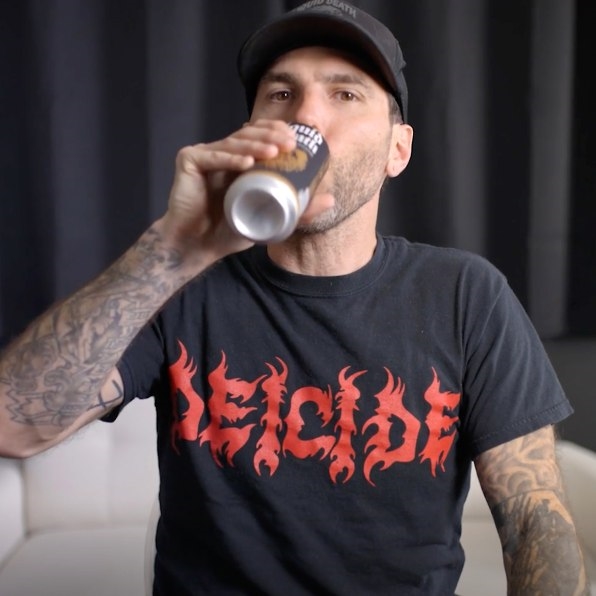Flush with cash: Why Liquid Death is looking at a future far beyond canned water
The first two comments on Martha Stewart’s Instagram post announcing her brand collaboration with Liquid Death last week really tells the story.
“Disturbing. Not funny,” one commenter posted.
“This is a very disturbing video,” wrote another. “In today’s day and age especially!!! The thought of chopping someone’s hand off and blood gushing is not funny…”
It’s exactly the reaction Liquid Death was aiming for when it paired with Stewart on a Halloween-themed candle of a black wax Liquid Death can held by a severed hand, and then convinced the food and home-decor legend to make an ad for it, in which she’s chopping off the hands of unsuspecting male fans. Cue the gushing blood.
The idea behind the collaboration is ultimately the same as the one that launched the brand in 2019. Take a traditionally quiet and buttoned-up category (water) and add some adrenaline-soaked irreverence. In the case of Stewart, we get the Dismembered Moments candle for $58.
Dismembered Moments offers us a look at the future that Liquid Death CEO Mike Cessario envisions for the brand. On the strength of its still, sparkling, and flavored waters, Liquid Death last week announced a $70 million series D led by Science Ventures at a $700 million valuation. Its 2022 revenue is on pace to hit $130 million, compared to $45 million last year, and the company expects that to double in 2023. And why not? When the brand launched its flavored sparkling waters on Amazon in January, within two months, it increased company revenues by 40%, without cannibalizing sales from its still or unflavored sparkling water.

[Photo: Courtesy Liquid Death]
Yet Cessario says Liquid Death’s primary product isn’t water of any kind. “At the end of the day, we’re a brand more than we’re a water company,” says Cessario. “The reason people buy Liquid Death and the merch has nothing to do with how many electrolytes our water has or what the ph level is.”
The real engine behind Liquid Death’s momentum so far, according to Cessario, is its ability to take a historically boring product category—water, in this case—and make it fun through its packaging, design, and content.
“One thing flavored [sparkling water] has helped us prove is that Liquid Death is a much bigger brand than just water in a can,” says Cessario. “Liquid Death has the ability to create a healthy beverage platform. We can make all kinds of healthy, better-for-you beverages, because all the brands in those categories are pretty boring and tame.”
The company says that’s where this new round of funding will help. That said, don’t expect a Liquid Death Kombucha any time soon. “Kombucha is a real pain in the ass to make,” says Cessario. “One reason we’re so successful is that we’re not trying to get into some niche product that doesn’t quite have a market yet. Water is a massive category—$26 billion in the U.S. alone —and you don’t have to explain to people what it is or how to use it.”
Critics point out that gimmicks only go so far. Early on, Cessario pitched Liquid Death at a BevNet showcase and was told by a Coke executive that irreverent brands don’t last. And this week on his Prof G podcast, discussing the new round of funding, Scott Galloway noted that while he thought Liquid Death was a great idea, being in a commodity product market among giants like Coke and Pepsi spelled out almost certain doom, comparing it to the DTC mattress brand Casper. “If I were the owners, I’d be praying for an acquisition at this point,” he said.
Cessario doesn’t agree with these limitations.“Dasani is just purified tap water in a plastic bottle, and they do $1 billion in revenue. Aquafina is just purified tap water in a shitty plastic bottle, and they do $1.2 billion in revenue,” he says. “Water is a category driven mostly by brand. So we build brand first, and we represent a point of view.”
If Google’s early mantra was, “Don’t be evil,” Liquid Death’s is probably “Don’t be boring” or “Turn everything into a Slayer T-shirt.” Whether using Tony Hawk’s blood on an actual skateboard, making an exercise video with comedian Bert Kreischer, Martha Stewart’s candle maiming, it’s all meant to be a fun and funny way to comment on the state of commercial culture. Most of which, according to Cessario, is terrible. “When people see our work they realize, ‘Oh! This company hates this bullshit as much as I do!’”
Cessario credits that point of view with selling more than $3 million in T-shirts and hoodies direct on its site last year, with demand growing for a wider variety of products and brand collaborations. Last Halloween, it teamed with Nixon on a $225 watch that sold out in four days.
“We realized people love to see this brand manifested in all different forms, other than just water,” he says. “Once people are entertained, then there’s a reason for someone to wear a T-shirt. There’s something there they identify with. You wear that shirt for the same reason you wear a band shirt, or a Gucci shirt. You’re trying to communicate something about your personality and interests.”
Now, much like how Gatorade has branched out beyond its drinks into gummies and sport bottle tech in order to reinforce and expand its locker-room bonafides among athletes, Cessario sees Liquid Death as a brand not tied to one specific product.
“We have these new avenues to bring the brand alive, and people are excited about it, and we have more to come,” says Cessario. “The candle is just another example that some of the most fun merch ideas are with seemingly the most mundane products.”
Like, say, water.
(30)


